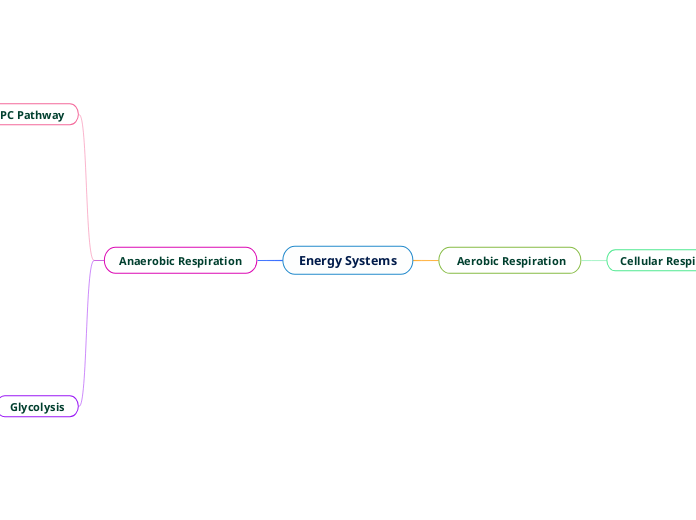Energy Systems
Anaerobic Respiration
ATP-PC Pathway
Yeilds enormus amounts of ATP
ADP releases kinase. Kinase breaks down the fuel source (Phosphocreatine) which releases energy
Has small amounts of stored energy
Stored ATP in the muscle breaks down which forms energy
ADP + P = ATP - ATP is the byproduct
When there is large amounts of energy, the body releases creatine kinase which then breaks down phosphocreatine which then releases energy
Creatine phosphate resynthesizes ATP which is where is generates from
Does not produce lactic acid
Limitations
-Pc only lasts 10s.
-takes 3-4 minutes to regenerate.
- Just one molecule of ATP is resynthesized for every molecule of Pc
-Pc only gets resynthesized with oxygen present.
Glycolysis
Produces glucose (food source)
Glucose breaks down to provide energy in ATP (yeilds 2)
Yields twice as much ATP as the ATP-PC pathway
Produces ATP without oxygen
Energy from glucose rejoins phosphate to ADP through chemical reactions
byproducts are ATP, pyruvate and NADH
glycogen gets depleated
occurs in the cytoplasm
The first Sequence of reactions
Limitations
-Depletion of oxygen
-Overall glycolysis is an inefficient means of energy production.
-only small amounts of energy can be used from the glycogen when under anaerobic conditions.
-Lactic acid is formed, which limits the increase of chemical reactions and denatures enzymes.
-Lactic acid also causes sore muscles
Aerobic Respiration
Cellular Respiration
Fats, proteins and carbohydrates are used
Preferred pathway after 90 seconds
Needs the complete breakdown of glucose
Uses a lot of ATP
yeilds 36 ATP
slow process which needs a lot of oxygen
water and CO2 is a byproduct
Involves three separate pathways
1) Glycolysis
-Enzymes split a molecule of glucose into two molecules of pyruvate, that then releases energy which is transferred to ATP.
-when oxygen is present pyruvic acid is converted to acetyl CoA instead of lactic acid
Limitations
--the energy yield during the process is very low when compared to the energy that is utilized
2) The Krebs Cycle
-Has eight reactions
-Has 2 molecules of ATP
-Complete cycle of reactions occur
-Citric acid is formed
Limitations
-Hydrogen peroxide limits the Krebs Cycle, which can limit the production of NADH
3) The Electron Transport Chain
-Yeilds large amounts of ATP (34)
-C02 and water are the byproduct
-Electrons get formed by water and that energy is then used to resynthesize ATP
Limitations
-Carbon monoxide limits the ETC
-
Limitations
-Slow process which requires oxygen, without oxygen the energy can not be converted.
- Faster pathway
- Occurs in the muscle fibre
- Uses chemicals and enzymes
-Very powerful, but shortened during physical activity
- More complicated pathway
- Happens in the mitochondria
- Needs many enzymes and several complex sub pathways leading to the complete breakdown of glucose fats and protein enter
